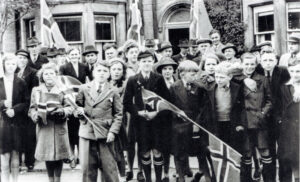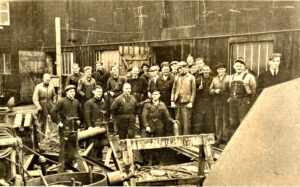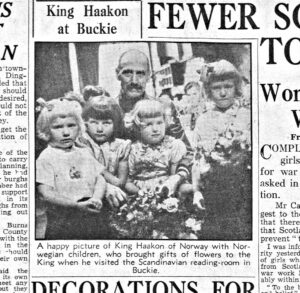Little Norway: when Norwegian was heard on the streets of Buckie as often as Doric.
Peter H Reid - as published in the 2022 Moray Field Club Bulletin
In 1940, following the German invasion, hundreds of Norwegian refugees – men, women and children – sailed across the North Sea in small fishing boats to seek refuge in Scotland. Most made for Shetland and the story of the Shetland Bus that followed is well known. However, Shetland could not house the numbers who came over and many were in turn relocated to Buckie, a town of some 8,000 inhabitants. Throughout the War, the Norwegian population of the town was in the region of four to eight hundred people. This led to Buckie being known as ‘Little Norway’.
In 2018, as part of European Year of Cultural Heritage, I led a project, in collaboration with Buckie Fishing Heritage Centre (www.buckieheritage.org), which researched the stories of the Norwegians and Danes who made Buckie their home during the Second World War. It drew on archival sources, oral history, personal stories and reminiscences, photographs, newspaper reports and other sources. The result was the Little Norway website (www.littlenorway.org.uk). We were also fortunate to secure an artist residency as part of the project. Working with the Fishing Heritage Centre, we applied to the NATUR project which was instigated as part of the European Union’s Year of Cultural Heritage 2018. NATUR was all about connecting Nordic Artists with one another and with the UK to creatively explore shared stories, culture and heritage. We were fortunate to have a sound artist, Eyvind Gulbrandsen, who worked with us across 2018. Eyvind was perfect choice as he is Norwegian but lives in Denmark. He had two residencies in Buckie and worked with P7 at Millbank Primary School and their recordings (of phrases in Doric and Norwegian) formed a central part of the scoundscape that Eyvind produced.
Tracing the story of the arrivals of the exiles from Norway was not always easy because of wartime censorship of the press, which saw a prohibition on the name of specific places in any report. It also involved working across multiple archives in three countries (using three languages) and not everything is, of course, available digitally. The Danish community had, more-or-less, already established itself by the end of May 1940, and remained relatively static save for a small second influx a couple of years later. It was entirely made up of fishermen who had been at sea at the time Denmark was occupied by the Germans and who opted to sail to Scotland rather than to return to Denmark. As one, Johannes Larsen, put it: ‘I will not fish for the Germans’.
The Norwegian arrivals continued for many months and that community was much more fluid than the Danish one, with some people staying and others just passing through. As the Norwegian population grew in Buckie (from autumn 1940 onwards), the Norwegian Government in Exile began to acquire properties in the town. Kintrae (now a Bed and Breakfast) at 39 East Church Street was one of the first to be taken. It was rented on a long-term lease from Mrs Nellie Clark, the widow of a weel-kent photographer who had used the shop next door as his studio. Kintrae served as the Norwegian Consulate throughout the War, firstly under Gustav Puntervold and then under Sverre Brosvik, his successor. Puntervold in particular, formed a very successful partnership with the Town’s Provost, William Merson, to ensure that all the Norwegians found homes, with many Buckie families giving up spare rooms to host Norwegians. Families were allocated any available empty properties across the town. Kintrae also house the Norwegian Fisheries Office, part of the Ministry of Commerce. The Fisheries Office was run by Thor Iversen one of the pre-eminent Norwegian oceanographers and fishery experts of his day. He was responsible for the practical day-to-day management of the fisheries and the office but also spent considerable time and effort in planning the shape of Norwegian fishing after the end of the war.
The town had a strong Norwegian feel because of this population. In addition to the consulate, there was a reading room and Seamen’s Mission (Sjømannskirken) which opened in the East Church Street in 1942. The reading room had originally been in Kintrae but was moved across the road to large premises, into the same building as the Seamen’s Mission (where Blythswood shop is today). Outside, it boasted a huge sign saying “Skandinavisk Leseværelse”. These facilities were open to all Danish, Norwegian and Swedish people in the town, whether resident or just passing through. There was a tiny handful of Swedes in Buckie; they were all fishermen who had been unable to return to home despite their homeland being neutral. Services at the Seamen’s Mission were taken initially on an irregular basis by Pastor Norman Salvesen of the Seamen's Church in Leith. Eventually, Pastor Bjarne Fjælberg came to the town and he remained right until the closure of the mission in 1946.
One of the most important elements for the Norwegian communities in the United Kingdom was the establishment of the Norwegian State Boarding School at Drumtochty Castle, a large and elegant early nineteenth century Gothic style mansion, is situated near the village of Auchenblae in Kincardineshire. The Castle was purchased by the Norwegian Government-in-Exile to serve as a boarding school for the children of Norwegian refugees. It was officially opened by King Haakon and both he and Crown Prince Olav paid a number of visits to it. The children of many of those who came to Buckie went to the school, including Håkon Lønøy who is detailed in the archives for his mischievous (often bad) behaviour. There were also many children whose parents were in Glasgow and London. Drumtochty was a safe haven away from the bombing and diseases of the big cities. There were normally up to eighty children at the school at any given time. The story of the school at Drumtochty Castle is currently the subject of Masters research by Ragnhild Bie Nielsen studying at Universitetet i Agder (and I have been co-supervisor of her research with Bjørn Tore Rosendahl at Arkivet in Kristiansand). Ragnhild’s research, which has including interviewing some of the surviving pupils (all in their eighties) as well as intensive archival work has shed new light on the school and what it meant for those who attended it.
With so many Norwegians and their boats in the town, the Ministry of Commerce of the Government in Exile decided to establish the Royal Norwegian Slip and Repairs Shops at Cluny Harbour in Buckie. It was built to take in hand the Norwegian fishing boats that had transported refugees across the North Sea and to ensure they remained seaworthy and so could contribute to the war effort. A Norwegian resistance fighter from Bergen called Frank Mohn was assigned responsibility for the construction of the boatyard. Frank had initially been training with the Free Norwegian Forces before sustaining a knee injury during exercises. The slip and boatyard were established in Commercial Road at the wester-most basin of the harbour (now filled in). Frank would return to Norway after the war and become one of its most successful businessmen (and a billionaire), establishing Framo Pumps.
The Norwegians were industrious and accomplished workers and they put their skills to good use, ensuring that the Norwegian fishing fleet could contribute to the war effort by landing catches but also by ensuring that the fleet could 'pick-up-where-they-left-off' back in Norway after the end of the conflict. Some boats were converted for military purposes.
One of the key figures at the Royal Norwegian Slip and Boatyard was Magne Jomar Hansen who was born at Loshavn, Farsund, on the southern coast of Norway, on 30 April 1895. He served on the D/S Borgfred for many years, eventually becoming its Chief Engineer. He was on the Borgfred when War was declared in September 1939 and served on board her until April of the following year when, after the occupation of Norway, merchant shipping came under the auspices of Nortraships (the state concern of the Government-in-Exile). He then served on the D/S Svint and D/S Heire until March of 1942. After being discharged from D/S Svint in March 1942, he came to Buckie. His skills, as a merchant fleet chief engineer, meant that he quickly became one of the most valued technicians at the Royal Norwegian Slip and Boatyard. He remained in Buckie for the rest of the war, overseeing the servicing and repair of both Norwegian fishing vessels and those which had been taken over for military service.
Magne lived with Maggie Jean McKenzie and her family at Findlater Street in Portessie, and the two families have remained in contact since the war. At the end of hostilities, Magne returned to Norway and brought his wife Ågot and daughter Aase back to Buckie as he was to continue working at the slip until it closed in 1946. During this time, the Hansen family lived in a house in Cliff Street. After the war, he returned to Norway and lived with Ågot and Aase in Farsund. Magne came back to Buckie to visit in the early 1970s and visited the McKenzie family. Not long afterwards Magne Hansen died at Farsund on 14 December 1975 at the age of 80 and he is buried there. Maggie Jean McKenzie's daughter, Charlotte McIntosh, has remained in regular contact with Aase who came to visit Buckie in the mid-1990s. Aase was interviewed in 2020 by the Norwegian newspaper Fædrelandsvennen which did a series of features in its weekend supplement about Buckie as Little Norway.
In July 1942, King Haakon VII and his son, Crown Prince Olav, visited Buckie.
The King and Crown Prince spent considerable time at the Norwegian Slip during their visit. There are a number of important archive photos of the King’s visit, including him with four little Norwegian girls on his knee in the Scandinavian Reading Room. The King's moral authority because of his famous 'No' to the Germans in April 1940 made him the visible symbol of both Norway and its resistance to the occupation. As years went by the affection and respect the elderly, gaunt king was held in grew and grew. His H7 monogram became a powerful symbol of resistance in Norway and one which the Nazis tried to ban. Still it kept appearing, painted on walls. The visit by the King of Norway to Buckie in 1942 remains an event in the consciousness of the town today, some eighty years on.
The Little Norway project also sought to record the stories of those who opted to stay in Scotland after the end of the War. About thirty remained, a mixture of Danes and Norwegian. Some stayed in Buckie, others went to different parts of the United Kingdom. Norwegian and Danish names are still much in evidence in Buckie today; the Langnes family still own and run FAL propellers which was established by Fred Langnes from Sørøya in Northern Norway. The Huldal family, the Thomsen family, the Rossvoll family and others remain in the town.
As these accounts show, the story of the Norwegians was all about people; people who had been forced to flee their homeland because of war and who longed to return. Most did but some never made it. One of the saddest little graves in Buckie New Cemetery is a tiny memorial to Aud Oline Ramstad. It is easy to miss it and walk on by.
Aud Oline Ramstad was born on 11 July 1935 in the Lofoten Islands. She had four siblings, Mildrid, Erling, Valborg and Gunvor. They all fled from the Lofoten Islands and, indeed, the Germans burned their house after they had left. Eventually, they came to live in Buckie but we are unsure how or when. The Ramstads lived at 2 Union Terrace in Buckpool. Little Aud Oline died on 5 June 1942, a month short of her seventh birthday having suffered from endocarditis and gastritis. Little Aud Oline is buried in the New Cemetery at Buckie and her grave is still tended by a member of the local community to this day.
Her family returned to Norway after the war, and her parents, Elias and Signe outlived their daughter, who lies in Buckie, by almost half-a-century. They had no house to return to but, in the words of their granddaughter, "the community looked after them". Elias and Signe died within a year of one another; Signe on 25 September 1989 and Elias on 18 April 1990. Many years later Mildrid, with her daughter Aud, visited Buckie and saw 2 Union Street and visited the grave of her little sister. For Mildrid it was a chance to close an important chapter in her life. Midrid is one of the little girls sitting on the knee of King Haakon in the photograph from 1942. Aud Oline is not forgotten in either Norway or Scotland.
In April 2022, four Norwegian sailors, Frode Stokkeland, Jarle Føreland, Tony Teigland and Willy Pedersen sailed Fri IV from Kristiansand to Buckie to commemorate their heroic compatriots who crossed the North Sea during the Second World War. They departed Norway on Wednesday 13 April and arrived in Buckie at 11.15am on Saturday, 16 April 2022. They were formally welcomed by Mrs Frances McKay, Deputy Lieutenant of Banffshire (on behalf of the Lord Lieutenant, representing Her Majesty the Queen). The carried with them a letter from the Norwegian Minister of Defence, thanking the people of Buckie for their support of Norway during the War. The motto for their trip was Aldri glemme, Norwegian for ‘Never forget’. Buckie never forgets.
Professor Peter Reid of Robert Gordon University, Aberdeen led the Little Norway project. His step-grandfather was Johannes Larsen mentioned in the third paragraph.



